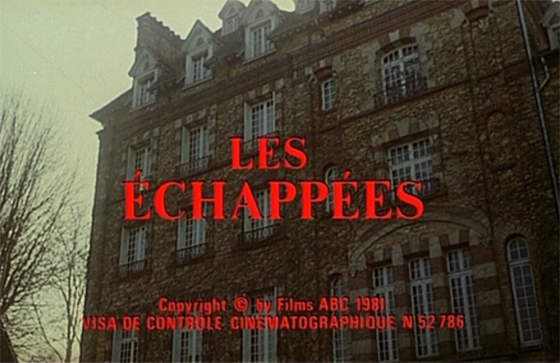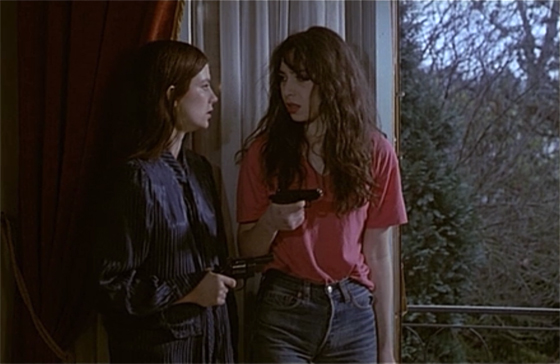
Following the intriguing Night of the Hunted (1980), Jean Rollin was asked to do a more straightforward and mainstream thriller. Though he was handed a script to match the mundane assignment, what he ultimately turned in was a most unexpected, eccentric, and downright personal film, The Escapees (Les Échappées, aka The Runaways, 1981). I would imagine that no one was pleased. There is little suspense to speak of. The film eschews the horror elements that were his stock-in-trade. Despite some nudity and the fleeting presence of Brigitte Lahaie, the film also rejects sexual exploitation, to such a degree that revulsion of sex is a critical element of the plot. This was a return to the Rollin of The Iron Rose (1973), a lyrical, even slow-moving film that finds the director at his most stubbornly anti-commercial. At times it is difficult to see that the film was made for anybody other than himself and his crew – a kind of vindication of exploitations past – but in the film’s brightest moments he manages to evoke the work of Jacques Rivette, Andrzej Zulawski, and François Truffaut. It’s a flawed film, and – if you don’t catch it in the right frame of mind – at times a bit dull. But as a window into an unexplored realm of the Rollinverse, it’s fascinating, radiating a warmth and nostalgia that has never been so foregrounded.
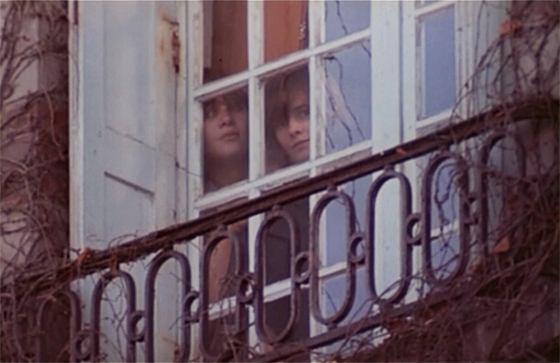
Michelle (Laurence Dubas) and Marie (Christiane Coppé) peer out from the window of their prison during the film's opening titles.
Throughout his filmography, Rollin was obsessed with paired females, sometimes twins (and preferably the Castel twins). The Escapees is about two young women, alike in some ways but crucially different in others: the innocent, childlike Marie (Christiane Coppé) and the adventurous and reckless Michelle (Laurence Dubas). In the opening scene we see these two caged birds peering out from a window in a mental health facility, a chateau in a misty French countryside. Then we witness what must be routine for them: Michelle rebelling until she’s thrown into a straitjacket (shades of Night of the Hunted); Marie in a rocking chair placed in the yard, rocking back and forth while staring forward vacantly. Soon Michelle is persuading Marie to free her from her straitjacket and loan her clothes so she can make her escape; Marie, in a sudden burst of yearning, begs to go with her, and the reluctant Michelle accepts. They see themselves as embarking upon a grand adventure together, and throughout the film they will tell each other tales of all the wonders they’ll see in the world. Instead, they travel through a land of trash and smog, chilly industrial wharves and smoky nightclubs. The two are virgins, and while Michelle is eager for her first sexual experience, Marie dreads it, and speaks in horror of a previous sexual advance a boy made to her (or was it an assault?).
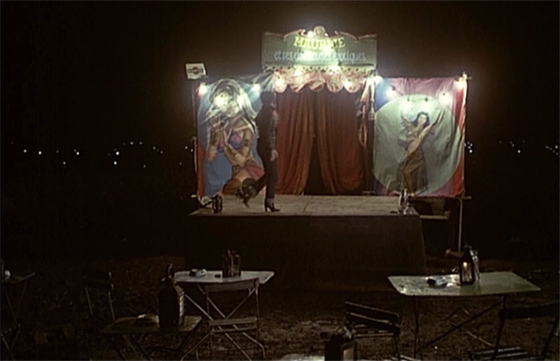
A traveling stripshow is deposited in the middle of a junkyard, just off the train tracks.
A constant dread hangs in the atmosphere; we await something terrible that will happen. (When the girls have their fortune read, we don’t see the crucial Tarot card, just the alarmed expression of the Tarot reader.) So it’s a pleasant surprise to see the two girls finding instead a loyal protector in the tough and leather-clad Sophie (Marianne Valiot), who’s so worldly that she’s not even offended when Michelle awkwardly tries to seduce her boyfriend Pierrot (Patrick Perrot). The girls drift from one extended family to another, first with a traveling troupe of exotic dancers, then the denizens of Sophie’s favorite dive, led by Rollin favorite Louise Dhour (Requiem for a Vampire, The Demoniacs). Such is the vibe of this film that at one point Rollin himself appears onstage at the club to introduce Dhour singing a sea-chantey. As for the stripshow, it’s an outdoor stage with tables and chairs hastily arranged in the junkyard before it; it appears to be a portal to another dimension, and indeed that’s another Rollin trademark, like the theater/wormhole in The Nude Vampire (1970). The actual onstage acts are dreary – some semi-clothed shimmying set to terrible contemporary music – but the enthusiastic reaction from the rowdy, pipe-sporting sailors is genuinely endearing (as is the fact that they seem to have emerged from a Popeye cartoon). In one of the film’s most surprising scenes – at least, for a Rollin film – Marie breaks into an ice rink at night, dons a skater’s uniform, and does a routine on the ice to the imagined applause of an invisible audience. Christiane Coppé had competed internationally as a figure skater, and Rollin uses the novice actress’ secret talent like an impressive card trick. Thematically, it works: we see Marie for the first time, and get echoes of her forgotten past, erased by the time spent in a mental institution. When Michelle arrives on the scene, she is our surrogate, sharing our surprise and wonder.
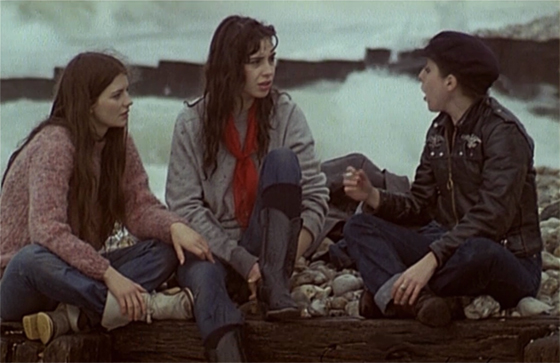
Marie, Michelle, and Sophie (Marianne Valiot) discuss escape plans.
The title’s meaning becomes clearer as the two girls make plans with Sophie to escape their gray lives by stowing away upon the ship that employs Pierrot. We know this grand scheme will not come to pass – there have been far too many bad omens. A late-night detour into a bachelor pad with some promiscuous couples turns suddenly to Repulsion-style violence, and Marie and Michelle finally find themselves bonded inextricably, committed to one another like two doomed lovers while the police gather outside the window with guns blazing. All this action happens in the last ten minutes of the film. Until then, it’s really a leisurely-paced study of life on the margins, examining sailors, hobos, prostitutes, and street thugs, all seeking escape, and sometimes just settling for escapism. It’s not a perfect film, and it may be best appreciated by those who have already traveled pretty far with Rollin, and are willing to indulge him a little (also, it helps to have a high degree of tolerance for low-key French dramas; I’m there already). But stick with it, and it makes for a pretty affecting love story.
